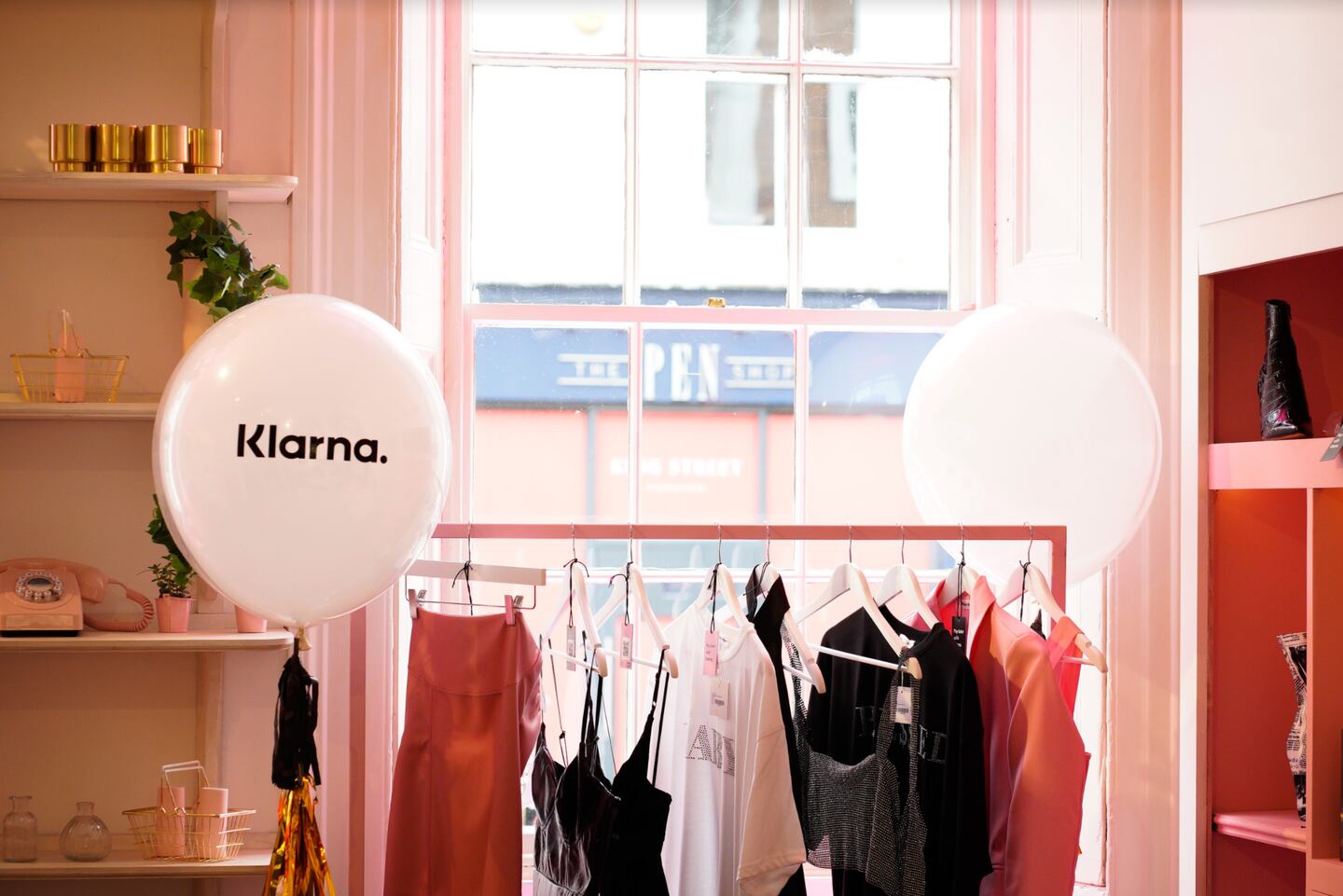
The Business of Fashion
Agenda-setting intelligence, analysis and advice for the global fashion community.

Agenda-setting intelligence, analysis and advice for the global fashion community.

This is a sponsored feature paid for by Klarna as part of a BoF partnership.
Founded in 2005 with a mission to offer a more flexible payment solution for shoppers online, Swedish tech company Klarna has rapidly evolved its scope and strategy to become a leading global retail bank, payments and shopping service. Today, it serves 90 million active consumers partnering with over 250,000 retailers globally and its own direct-to-consumer shopping app. It counts H&M, Ganni, Charlotte Tilbury, Macy’s, Acne Studios and Sephora among its roster of clients.
The pandemic has accelerated online shopping and with that, the adoption of Buy Now, Pay Later options, as risk averse customers demand flexibility and transparency when purchasing investment pieces across a variety of categories. At BoF Voices 2020, we shared data identifying Buy Now, Pay Later as the fastest growing online payment method in Australia, Brazil, France, Japan, the Netherlands, the United Kingdom and the United States, and is set to grow at a 28 percent compound annual growth rate globally over the next five years.
Today, Klarna has expanded its reach and services to become an intrinsic part of the overall shopper experience. A recent partnership with Cosmopolitan magazine resulted in a virtual shopping holiday incorporating livestream technology, empowering customers to shop brands such as Macy’s, Rebecca Minkoff and Adidas, among others — all in real time. Meanwhile, an in-game virtual shopping experience on Nintendo’s Animal Crossing featured shoppable pieces by The North Face and Marine Serre, while the rollout of Klarna’s payment solutions across physical retail locations have answered customer calls for flexibility in-store to match that available with online retail.

Now, BoF sits down with Klarna CEO Sebastian Siemiatkowski to discover the evolving dynamics between Klarna and its partners, and the new technologies innovating the path to purchase.
What insights can you share on evolving consumer attitudes to payments?
The ongoing shift away from traditional credit cards and towards debit has been accelerated and further amplified by the pandemic. Credit card applications have dropped 50 percent while over $100 billion worth of credit card debt has been paid off. Consumers are [recognising] that traditional credit cards are not a great business model.
Many of us have credit cards and we sometimes get an interest-free period or loyalty points, but we seldom ask, “Where is that money coming from?” The unfortunate fact is there is a subset of customers in revolving debt, with 29 percent interest rates, that are paying for the rest. Alternative options that allow customers to pay over time [democratise] the payment process. In that sense, retailers who are willing to take those bets with us are part of transforming the industry.
Additionally, we’re tracking how the pandemic has accelerated the shift to contactless. Shoppers really love the Apple Pay and Google Pay experience, and we have launched a number of in-store initiatives, including virtual cards for digital wallets. This has facilitated alternative payment options within physical stores while also [answering] consumer demand for access to contactless solutions.
How is the relationship between Klarna and its merchant partners evolving?
I generally think about retail in two different pieces. One is around discovery and curation, while the other piece is purely the product and brand. When we are trying to help retailers, it’s about presenting their customers with useful, curated options. There’s always been this idea that a payments company or bank, because of our consumer insight, can help the seller to curate more efficiently.
Historically, if you think about sources like the Amex Platinum Card, part of the idea was the [customer] would go into a restaurant and the owner would think, “It’s a Platinum Card, so I need to ensure I offer my best wines and food.” At Klarna, we can help our retail partners curate more efficiently with the consent and interest of the consumer in mind.
Data must be approached from a customer-centric perspective.
For brands who are focused on developing great products or brand affinity, what’s critical for them is exposure and product visibility. We are trying to help them find new channels, new [strategies] and new customers, but letting the brand control how and where they present themselves. Now, because we have thought about our own brand affinity, we have evolved our partnerships. Our co-marketed campaigns such as the Bulgari x Klarna Pink Edition or our Olivia Rubin X Klarna Pop-Up Nail Bar have driven really positive results for both Klarna and the retailer.
How is customer data shared and actioned between Klarna and its partners?
Thanks to granular data, Klarna has a great understanding of consumer habits and spending patterns. However, I think there has been a lot of industry learnings about when data sharing can go wrong. At Klarna, data must be approached from a customer-centric perspective first, which then benefits our retail partners.
When we process a transaction today, Klarna sees the SKU (stock keeping unit) data and full digital receipts, which allow us to create a much richer experience for consumers post-purchase. We can provide customers with additional value, such as target offers relevant to past purchases, or additional items that could match their interests. It can [translate] into an increase in sales for our partners, while bringing something compelling and relevant to the shopper.
One further data aspect is our Wish List functionality on the Klarna app, where we allow customers to save their favourite items from across the internet. We have seen over 7 million items Wish Listed in the last six months. If a shopper has saved a pair of shoes, they will be linked to offers on the item or an indication on where to purchase if it has gone out of stock. The customers feel like their data is working on their behalf and that is valuable to our retailers.
What new technologies are innovating the path to purchase?
Right now, I think the live shopping piece is very interesting. What we’re trying to do in our partnerships is consider quick integration. What new things can we try? For retailers, it is about daring to iterate [new technologies]. We feel that many [retailers] get stuck in the idea of which technology can win, or is a sure bet, but it hugely limits them.
This is one of the reasons we have had a lot of success with Klarna’s in-store offering. When we launched it, we made sure that the first iteration would work immediately. Effectively, you could put up a sign in the store and enable quick testing on the spot. There may be other things that we want to improve from a user-experience perspective that need some tech work, but if that starts limiting us, then we become too slow.
What payment solutions and technologies should luxury brands prioritise?
In luxury fashion, we are seeing the most traction with our product offerings that allow customers to pay in three or four interest-free instalments, depending on the market they are in. Where we see a big opportunity is with our Try Before You Buy offering, where consumers pay nothing at the time of purchase and pay everything 30 days later. We’re seeing it in China, with Buy Now Pay Later accounting for 50 percent of Alipay’s total volume, and we have seen Amazon already beginning to experiment with [this solution] as part of the Amazon Prime Wardrobe offering.
What we’re trying to do in our partnerships is consider quick integration. What new things can we try?
Try Before You Buy is similar to the old consignment sales concept that used to exist in boutiques, where VIP customers could come to the store, select items, walk straight out and pay for the items they kept at the end of the month. While brands are nervous about returns, we have seen this offering drive an immense amount of loyalty and increase of spend with the most prominent customer base.
How is Klarna preparing for customers returning to physical stores, post-pandemic?
As a tech company, we have had 16 years of experience working with retailers. We have a good opportunity to come in and help them bridge some of their legacy issues so that they can accelerate their customer [offering]. We are super excited about this aspect. Today, we have a very packed product roadmap for in-store partnerships. In total, almost 80,000 stores now offer Klarna. We were one of the first [payment] companies to roll out in-store, and we are now live with Macy’s, Sephora and Foot Locker, to name a few.
There has been a lot of discussion about the omnichannel experience, but putting that into practice and making something that really works for customers has taken more time. We have seen Buy Online, Pick Up In-Store [growing], but we’re looking to Burberry — and its use of WeChat in China — for amazing examples of combining the digital and offline experience. When we looked at our roadmap for both the US and Europe, we are considering how we can bring the digital experience to the offline space and vice versa. How can we help people find the stores and bring them inside?
From analysis of the global fashion and beauty industries to career and personal advice, BoF’s founder and CEO, Imran Amed, will be answering your questions on Sunday, February 18, 2024 during London Fashion Week.
The State of Fashion 2024 breaks down the 10 themes that will define the industry in the year ahead.
Imran Amed reviews the most important fashion stories of the year and shares his predictions on what this means for the industry in 2024.
After three days of inspiring talks, guests closed out BoF’s gathering for big thinkers with a black tie gala followed by an intimate performance from Rita Ora — guest starring Billy Porter.